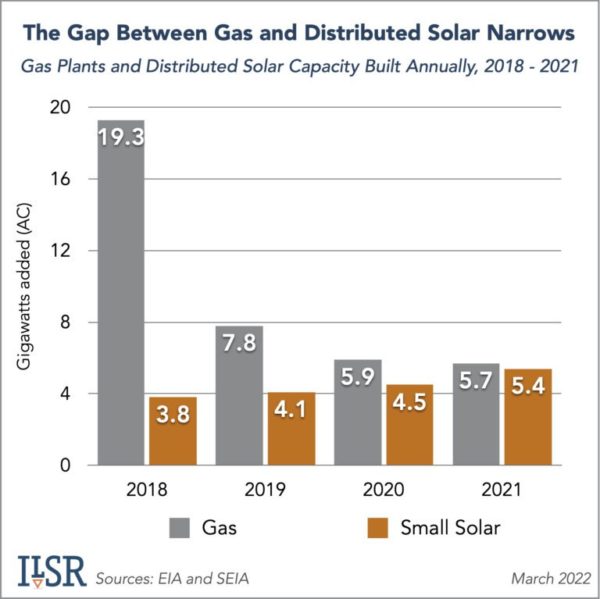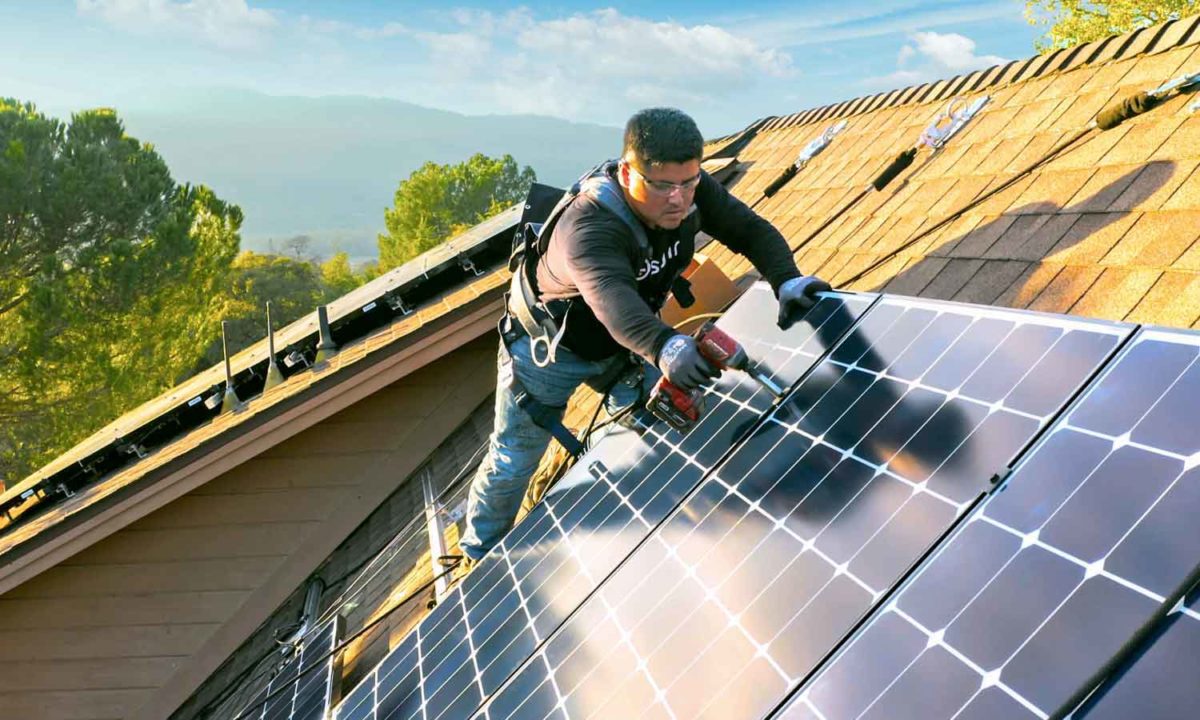Demand for electricity in the US is growing as more people power cars, appliances, and home heating with electricity rather than fossil fuels. But to be powered by clean energy, that electricity must be generated by renewable sources. According to the ILSR annual update, choosing to build renewable generation resources has become the norm rather than the “alternative.”
In 2021, for the first time ever, nearly half of new electric generation capacity added to the grid was from solar. Long overlooked as a scalable resource, the distributed solar installed in 2021 nearly matched the capacity of all gas plants built last year. And while this is a first, it is a trend that has been building because, in the last decade, there have been only two years in which the capacity from new gas plant construction outpaced renewable energy buildout.
The gap between gas and distributed solar has been narrowing for several years. In 2021, added gas and small solar capacity were almost equal; 5.7GW worth of gas plants were built this year, while developers installed 5.4GW worth of residential and customer solar.

According to SEIA and Wood Mackenzie, solar developers installed over 500,000 residential solar projects in 2021, despite many challenges including interconnection delays or other prohibitive policies set by utilities. However, there is some good news: thanks to a ruling by the US Ninth Circuit Court of Appeals, utilities may be subject to antitrust litigation for their anticompetitive behavior.
Another challenge is net metering rule changes, as seen in California, Florida as well as other states. In Florida, for example, House Bill 741 and Senate Bill 1024 (passed and awaiting the Governor’s signature) aim to dramatically reduce the benefits of net metering for customers.
Also of concern is disproportionate support for wealthier Americans when it comes to going solar. According to research by the Rocky Mountain Institute, the current federal solar investment tax credit has disproportionately benefited wealthier, higher-income, and often whiter households. Changing this incentive to a refundable or direct pay tax credit would help more Americans go solar.
Despite these challenges, solar and other renewable generation resources are proving to be more cost-effective than fossil fuel generation.
Many states and cities have set resolutions to be carbon neutral in two or three decades. Many, however, need to rethink building new gas plants because with a lifespan of 40 years, the states would have little chance of meeting carbon-neutral goals.
Solar breaks records in fourth quarter 2021
New generation capacity in Q4 2021 was just under that of 2020’s: 14GW new gas, wind, large solar, and distributed solar resources came online. Both large and small solar broke their respective records for quarterly growth. Paired with a surge of new wind generation capacity (more than double the capacity added last quarter), renewable resources contributed 85%of generation capacity buildout this quarter.
Distributed solar broke records—again. Despite supply chain delays, 1.6GW of distributed solar capacity were installed in Q4 , breaking the previous quarter’s record. If the federal government extends or tweaks the federal investment tax credit, the demand for residential solar could grow even faster.
This content is protected by copyright and may not be reused. If you want to cooperate with us and would like to reuse some of our content, please contact: editors@pv-magazine.com.









“Many states and cities have set resolutions to be carbon neutral in two or three decades. Many, however, need to rethink building new gas plants because with a lifespan of 40 years, the states would have little chance of meeting carbon-neutral goals.”
Building a gas plant doesn’t mean it will be used all that often. The reasonable studies I’ve seen are predicting gas being used for the last 5 to 10% of the electricity supply. Technically we have sufficient sources of waste gas from water processing plants, landfills, dairies etc. to fuel these gas plants such that they supply 3 to 5% of our annual electricity. Note, these fuels would likely be carbon negative. We could easily grow biogas crops to fill in the rest if we wanted. Interestingly, biogas crops produce 2 to 3 times as much energy per acre as ethanol crops.
There is a fascinating technology that recently came out of NREL which uses super-heated sand to store energy. The technology has energy storage costs of $2 to $4/kWh. The US uses something like 3000 to 3500 TWh of process heat a year. It’s not hard to imagine NREL’s technology being used in a hybrid arrangement where the primary purpose is to store heat (at 95% efficiency), tap the storage for electricity (at 50% efficiency) for a few hundred hours a year and fuel the combined cycle plant with gas for the last sliver of coverage. The economics appear to be exceedingly feasible.
When you have it so the process heat is the primary end-use of the thermal storage you make it so the capacity factor of the thermal storage is much higher than it would be if you were just turning heat into electricity. Large-scale grid batteries are currently being operated at 4 to 5% usage factors. These already low usage factors are projected to sink lower still as we reach higher penetrations of wind and solar. Most people seem to think wind and solar help storage but this is completely false. Relatively simple energy modeling shows electricity storage getting mostly squeezed out of the picture. This is due to a combination of over-built RE, flexible thermal storage and flexible EV load.
If the reports are referring to “installed capacity” and not “annual potential production” it is giving a skewed view of where we are in the move to renewable energy(its not the alternative..its the imperative). Wind capacity factors are usually around 40% and solar may be at 20-25%. Although I am a life long proponent of solar and wind I think it is important for us to be careful how we frame things. Of course if the nat gas plants are only used as peakers then the opposite may be true. While solar and wind’s actual generation can be predicted(with some variability) the use of a nat gas plant is open to corporate policy which makes the use of “capacity factor” a bit more problematic.